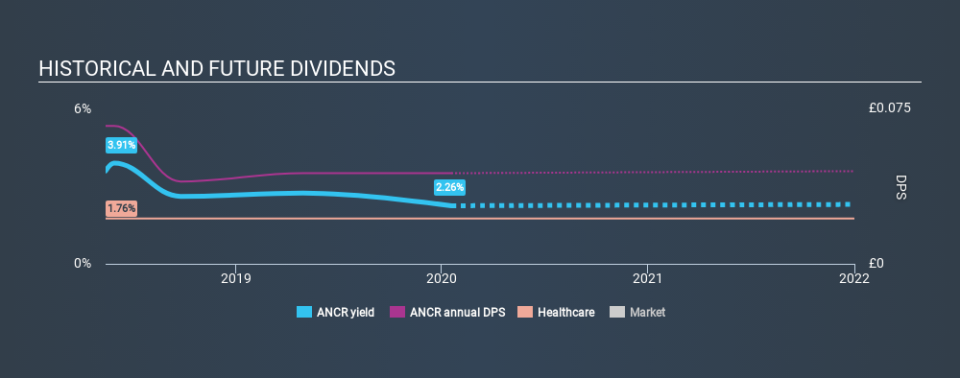Is Animalcare Group plc (LON:ANCR) A Good Dividend Stock?

Today we'll take a closer look at Animalcare Group plc (LON:ANCR) from a dividend investor's perspective. Owning a strong business and reinvesting the dividends is widely seen as an attractive way of growing your wealth. On the other hand, investors have been known to buy a stock because of its yield, and then lose money if the company's dividend doesn't live up to expectations.
Some readers mightn't know much about Animalcare Group's 2.3% dividend, as it has only been paying distributions for the last two years. A low dividend might not be a bad thing, if the company is reinvesting heavily and growing its sales and profits. Some simple research can reduce the risk of buying Animalcare Group for its dividend - read on to learn more.
Explore this interactive chart for our latest analysis on Animalcare Group!
Payout ratios
Dividends are typically paid from company earnings. If a company pays more in dividends than it earned, then the dividend might become unsustainable - hardly an ideal situation. Comparing dividend payments to a company's net profit after tax is a simple way of reality-checking whether a dividend is sustainable. Although Animalcare Group pays a dividend, it was loss-making during the past year. When a company recently reported a loss, we should investigate if its cash flows covered the dividend.
Animalcare Group paid out a conservative 37% of its free cash flow as dividends last year.
Is Animalcare Group's Balance Sheet Risky?
Given Animalcare Group is paying a dividend but reported a loss over the past year, we need to check its balance sheet for signs of financial distress. A quick check of its financial situation can be done with two ratios: net debt divided by EBITDA (earnings before interest, tax, depreciation and amortisation), and net interest cover. Net debt to EBITDA measures total debt load relative to company earnings (lower = less debt), while net interest cover measures the ability to pay interest on the debt (higher = greater ability to pay interest costs). With net debt of 2.34 times its EBITDA, Animalcare Group's debt burden is within a normal range for most listed companies.
We calculated its interest cover by measuring its earnings before interest and tax (EBIT), and dividing this by the company's net interest expense. With EBIT of 2.73 times its interest expense, Animalcare Group's interest cover is starting to look a bit thin.
Consider getting our latest analysis on Animalcare Group's financial position here.
Dividend Volatility
Before buying a stock for its income, we want to see if the dividends have been stable in the past, and if the company has a track record of maintaining its dividend. It has only been paying dividends for a few short years, and the dividend has already been cut at least once. This is one income stream we're not ready to live on. During the past two-year period, the first annual payment was UK£0.067 in 2018, compared to UK£0.044 last year. Dividend payments have fallen sharply, down 34% over that time.
We struggle to make a case for buying Animalcare Group for its dividend, given that payments have shrunk over the past two years.
Dividend Growth Potential
Given that dividend payments have been shrinking like a glacier in a warming world, we need to check if there are some bright spots on the horizon. Animalcare Group's earnings per share have shrunk at 52% a year over the past five years. A sharp decline in earnings per share is not great from from a dividend perspective, as even conservative payout ratios can come under pressure if earnings fall far enough.
Conclusion
Dividend investors should always want to know if a) a company's dividends are affordable, b) if there is a track record of consistent payments, and c) if the dividend is capable of growing. We're not keen on the fact that Animalcare Group paid dividends despite reporting a loss over the past year, although fortunately its dividend was covered by cash flow. Second, earnings per share have been in decline, and its dividend has been cut at least once in the past. Overall, Animalcare Group falls short in several key areas here. Unless the investor has strong grounds for an alternative conclusion, we find it hard to get interested in a dividend stock with these characteristics.
Are management backing themselves to deliver performance? Check their shareholdings in Animalcare Group in our latest insider ownership analysis.
If you are a dividend investor, you might also want to look at our curated list of dividend stocks yielding above 3%.
If you spot an error that warrants correction, please contact the editor at editorial-team@simplywallst.com. This article by Simply Wall St is general in nature. It does not constitute a recommendation to buy or sell any stock, and does not take account of your objectives, or your financial situation. Simply Wall St has no position in the stocks mentioned.
We aim to bring you long-term focused research analysis driven by fundamental data. Note that our analysis may not factor in the latest price-sensitive company announcements or qualitative material. Thank you for reading.



